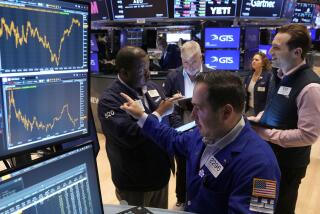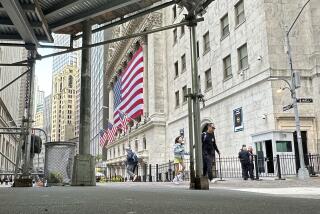LinkedIn: Getting it while the getting is good
So much of what people thought they knew about investing has been turned upside down in the last decade.
Yet Linked-In Corp. showed this week that some things never change: Offer stock in one of the hottest U.S. companies in one of the hottest new industries and watch the public beat down the doors to get at it.
Who says Americans have given up on the future? They clamored to grab a piece of it in LinkedIn.
The initial public share offering of the Web-based professional-networking firm was expected to be a hit, and it more than lived up to expectations. The Mountain View, Calif., company went public at $45 a share late Wednesday and saw demand explode when the stock began trading Thursday morning.
After some truly desperate buyers briefly drove the shares as high as $122.70, the price pulled back but still closed up 109% for the day, at $94.25. That ranked as the biggest first-day IPO advance for any U.S.-based tech company since the crash of the dot-com era stocks in the early 2000s, far exceeding Google Inc.’s 18% initial pop in its 2004 IPO.
Understandably, Linked-In’s surge triggered “Bubble!” catcalls from people who would prefer not to see history repeat. Though the stock’s gain was relatively modest compared with the 400%-plus first-day rallies of the dot-com era’s shooting stars, the $94.25 share price still was an astronomical 554 times the company’s earnings of 17 cents a share last year.
On Friday the stock eased slightly, ending at $93.07.
Nobody doubts that LinkedIn, with 102 million members, is a real business right now. But what level of future earnings are buyers at $90-plus betting on? It had better be a very big number.
Whatever opinion you might have about this kind of speculative frenzy for a stock, as taxpayers we probably ought to be grateful for LinkedIn. Hopefully, the windfall to fellow Californians who sold LinkedIn shares at a profit Thursday and Friday will yield a tidy capital-gains tax bonus to cash-strapped Sacramento. Maybe it will save a state park or two from closure.
And if LinkedIn paves the way for similarly torrid investor receptions for IPOs from the rest of the California social networking mob — particularly Facebook, Twitter and Zynga — don’t underestimate the benefit to the state’s coffers. Or to the luxury-home market in and around Silicon Valley, as newly minted millionaires look for real estate befitting their upgraded financial status.
Somebody else ought to be happy about the Linked-In deal: Federal Reserve Chairman Ben S. Bernanke.
The Fed’s easy-money policy, including near-zero short-term interest rates, has been expressly aimed at encouraging investors to take risks with their savings rather than stay hunkered down earning nearly nothing.
And by trying to hold long-term interest rates down as well since November with its commitment to buy $600 billion in Treasury bonds, the Fed has sent a clear-cut message to businesses: Why not raise capital while it’s so cheap?
In other words, get it while the getting is good.
But just how much longer the getting will be good is a matter of growing debate on Wall Street.
The Fed’s bond-buying program is set to end June 30. People who believe that the only thing holding up the U.S. economy over the last six months has been Bernanke’s cash injections are betting that things will crumble just as soon as those injections stop.
If so, LinkedIn’s IPO could be remembered as a last gasp of the bull market. For now, though, U.S. stocks overall remain in wait-and-see mode. Most major indexes fell just modestly this week and remain within 4% or so of their multiyear highs reached in late April. There has been no big rush for the exits.
Bond investors, too, have been sanguine, seemingly ignoring warnings from the likes of Pimco bond fund guru Bill Gross, who insists that once the Fed’s Treasury purchases wind down, longer-term interest rates must rise because they’ve been artificially suppressed.
If Treasury rates jump, that would be expected to push up other interest rates as well, including on mortgages and corporate bonds, for example.
No wonder corporate America has gone on a borrowing binge to raise fresh capital or refinance more expensive debt. U.S. companies have raised a total of $360.5 billion this year via sales of investment-grade and junk bonds, already more than half of what they raised in all of 2010, according to data firm Dealogic.
This week alone was the busiest ever for corporate borrowing, with $30.3 billion in bonds sold, Dealogic said.
Get it while the getting is good.
Even Google, already loaded with cash, couldn’t resist taking advantage of low bond yields. The Internet search giant this week sold debt for the first time in its history, raising $3 billion in all.
The Fed’s many critics can hold up the LinkedIn and Google transactions as arguments for what’s fundamentally wrong with the central bank’s easy-money policy: It encourages speculation, they say, and it gets more money into the hands of people who don’t need it while doing little or nothing for the truly cash-strapped.
They have a point. While major companies can borrow freely in this market, millions of homeowners could only look on ruefully this week as average 30-year mortgage rates fell to 4.61%, the lowest level since early December. If your house is worth less than your mortgage, you aren’t going to get the chance to refi.
Likewise, even though investors’ appetite for tax-free municipal bonds has risen in the last three months, pushing yields down, many state and local governments have had to swear off borrowing as they struggle to slash spending to close budget holes.
In an economy where the gulf between the haves and have-nots has widened drastically since the financial crash of 2008, easy money continues to be a boon to the haves, while most of the have-nots keep waiting for relief.
Unsatisfying as this situation may be, even the have-nots should be hoping that the bears are wrong about the fate of the economy and the markets after the Fed ends its latest stimulus program.
A surge in interest rates and plummeting stock prices would be painful for the haves, but it isn’t as if that would make things better for everyone else.
More to Read
Inside the business of entertainment
The Wide Shot brings you news, analysis and insights on everything from streaming wars to production — and what it all means for the future.
You may occasionally receive promotional content from the Los Angeles Times.










